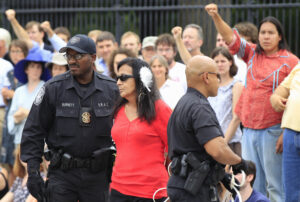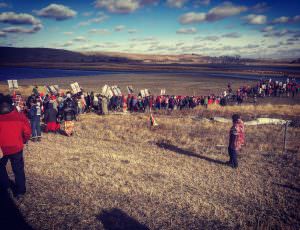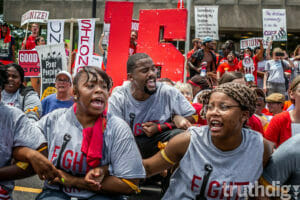The Water Protector Movement Is Really One Battle in a Centuries Old Fight
The Native American people do not view #NoDAPL as a protest but as an act of survival. It is the continuation of resistance to repression and oppression.
CANNON BALL, N.D.—As a few hundred people sat in a group, Harmony Lambert, one of two seasoned volunteers, ended her training session.
“We are here to stop the pipeline. It is not about protesting,” Lambert said. “The goal is to be strategic. Keep that in mind.”
The acts of civil disobedience she was referring to were directed toward Energy Transfer Partners, the Texas-based company building the Dakota Access pipeline. When construction is disrupted, it costs Energy Partners a reported $2.2 million a day (not including the drop in its stock prices). Training shows the “water protectors” how they should react to, and endure, violence from opposition forces — the police and pipeline security personnel.
The members of the Standing Rock Sioux Tribe are unequivocally nonviolent. The commitment to nonviolence is clear and has been repeatedly demonstrated. It doesn’t mean they are pacifists, but they understand that a battle cannot be won by throwing a rock at a tank. In training DAPL protesters, they explain that women, the elderly and Native American people are always the first to be assaulted by the police, and the leaders teach the group how to protect the vulnerable, knowing that in moments of confrontation, chaos ensues.
Tuesday, a group of activists, Native American and other, went to a DAPL storage unit. They were protesting the “man camps,” where out-of-town pipeline workers stay and people on the ground allege that Native American women have been sexually assaulted and gone missing.
On the water protectors’ side, the confrontation was nonviolent. They stood in a line in front of the police. With the help of a tank, the police marched forward through the line after a prayer circle ended. Their protest was over, and participants peacefully returned to their cars as fast as possible. That’s when — unprovoked — officers attacked with Mace and pepper spray, mostly targeting women. While those attacked scream and cry, police in full riot gear used their momentum to advance. A female officer looked distraught the entire time and, at one point, even appeared to tear up. Twenty-seven people were arrested.
Because of the tank and two empty buses waiting to hold arrestees, the police action appeared planned. They told those not arrested to get in their cars and leave safely — but blocked the highway, leaving no way out. Police then approached cars, pointing a camera at participants. People on the ground all said it was a facial recognition system and that the police used this to help them target Native Americans or the leaders.
Despite the opposition forces against them in their mission against the DAPL, the Standing Rock Sioux continue to resist. They do not use the word “protester” because they view themselves as “protectors”— of their water, land, ancestry and future generations. They are standing up to centuries of repression and oppression.
The pipeline is being built through land that belongs to the Native Americans under the Treaty of Fort Laramie of 1851. At the time, the United States recognized that the treaty land was what was then called Indian territory and not part of the United States. Energy Partners does not care, and the U.S. government has not stopped the company until recently. Monday, the Army Corps of Engineers said pipeline construction could not continue without tribal input. Tuesday, Energy Partners filed a federal lawsuit to finish the pipeline without Corps approval. The pause appears temporary as they “investigate” whether the pipeline is being built on sacred, Indigenous burial sites. There is no talk of ending construction. The interruption could end up being nothing more than a delay tactic until President-elect Donald Trump is in office. Trump has financial ties to Energy Partners.
The protector line, which tends to be the only thing covered by the media about the DAPL, is just one small fraction of the movement at Standing Rock. Thousands of people have poured into the resistance camps from all over the world to show their support. They live in three camps: Oceti Sakowin, Standing Stone and Rose Bud. (Oceti Sakowin is the camp where I am staying.) There was a fourth, but during a day in which the elders were supposed to have negotiations with the police, the police destroyed it. Clothing and other items were later returned covered in urine, according to the protectors, who put everything in a pile and burned it.
The campers prepare food, provide shelter and pray together.
If a revolution happens in America, the #NoDAPL movement may be the source, and the camps at Standing Rock will be the epicenter.
The weather at night is so cold that some people, their faces buried under blankets, wake up to layers of frost covering their bodies. People are preparing for winter, as North Dakota, with its heavy winds, becomes one of the coldest places in the country. A foot of snow is expected Thursday. The protectors are hoping more people and supplies arrive, as a mist of anxiety settles on the camps.
The police are ever-present. Often, the sounds of airplanes and drones above can be heard, similar to the sounds of battle scenes in a war movie. On the route to any protector line, a police helicopter is always following. On the ridge, the police trucks and surveillance spy vans can be seen. Multiple people have reported full takeovers of their phones from external forces in ways they had never experienced.
The #NoDAPL movement functions differently from those like Occupy. The people here are not equals, and the “white” folks that come are reminded that they are guests in someone else’s home. They must respect the elders and the coalition of the Oceti Sakowin, or Seven Council Fires, the traditional name of the Great Sioux Nation.
On the way to the front lines, the rank-and-file resisters don’t know where they are headed. The action is kept secret so that undercover police can’t co-opt it. Everyone trusts the Native Americans.
“The Native Americans have been fighting this fight for centuries,” explained Maricella Uribe, an activist. “The movement is focused around the pipeline. But we are digging up old trauma and seeing how we can deal with that today. How can we go on? How can we move forward, acknowledging the past?”
In North Dakota, racism is ubiquitous. Over the weekend, a white cement worker drove to a protest action, shot his pistol in the air and pistol-whipped a woman. Such violence is symptomatic of the greater disrespect Native Americans face.
“They treat their land terribly,” Andrea, a white Republican masseuse from North Dakota, told me on my flight from Denver to Bismarck, N.D. “They don’t know what they want. … [T]hey just seem very lazy. Their reservation looks like Tijuana.” Throughout our conversation, she kept saying, “I know this sounds wrong but…” To her, the Native Americans should be grateful for the land “they were given.” She added that only the “lazy” tribes that didn’t get oil money are the ones protesting.
Despite this lack of understanding and awareness, the #NoDAPL movement has united the seven Sioux nations for the first time in over a century. More than 300 groups have joined in solidarity. It is believed to be the largest coming-together of Native Americans in history.
Andrea said that people need the pipeline for jobs. For this reason, “Donald Trump will save North Dakota.” With regard to spills, she and her friends “know for certain” that modern technology is so great— with too much oversight — for a spill to ever happen. Yet according to CNN Money, pipelines burst and spilled 132 times in 2015, or at least once every three days. In the first eight months of 2016, there were 80 spills. And many small leaks are never even reported.
A Dakota Access pipeline spill would poison the Missouri River, the main source of drinking and irrigation water for the Standing Rock Sioux and potentially 18 million other people. The slogan “water is life” is pervasive through the chants and banners. The #NoDAPL movement continues to grow.
As the moon rose Tuesday, prayers and songs were heard throughout the camp. On the ridge, only the bright lights of the pipeline remained visible.
The protectors were preparing for a cold winter and more acts of peaceful resistance.
Your support matters…Independent journalism is under threat and overshadowed by heavily funded mainstream media.
You can help level the playing field. Become a member.
Your tax-deductible contribution keeps us digging beneath the headlines to give you thought-provoking, investigative reporting and analysis that unearths what's really happening- without compromise.
Give today to support our courageous, independent journalists.






You need to be a supporter to comment.
There are currently no responses to this article.
Be the first to respond.